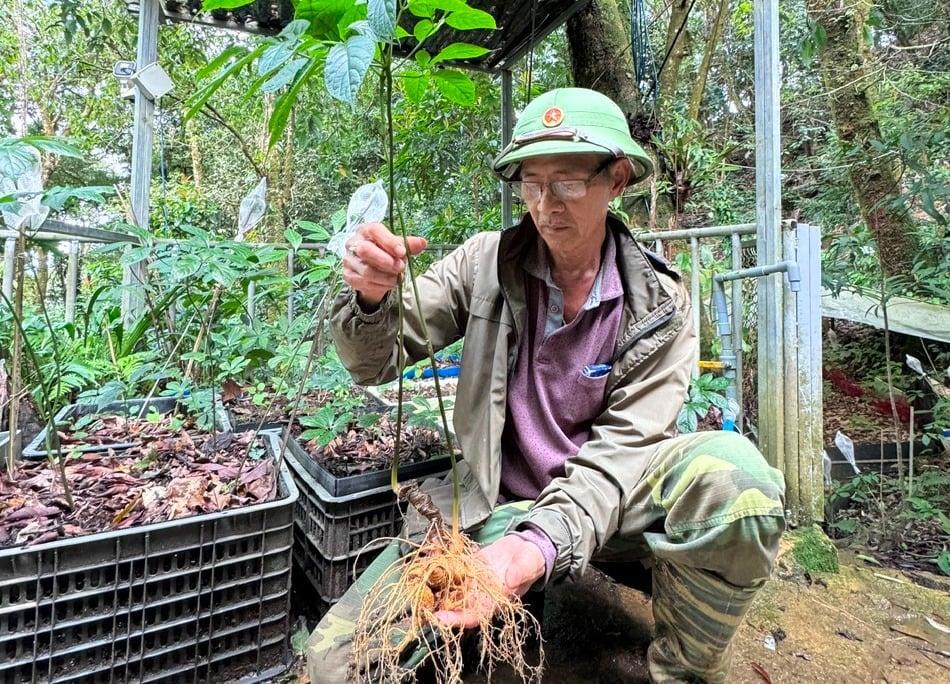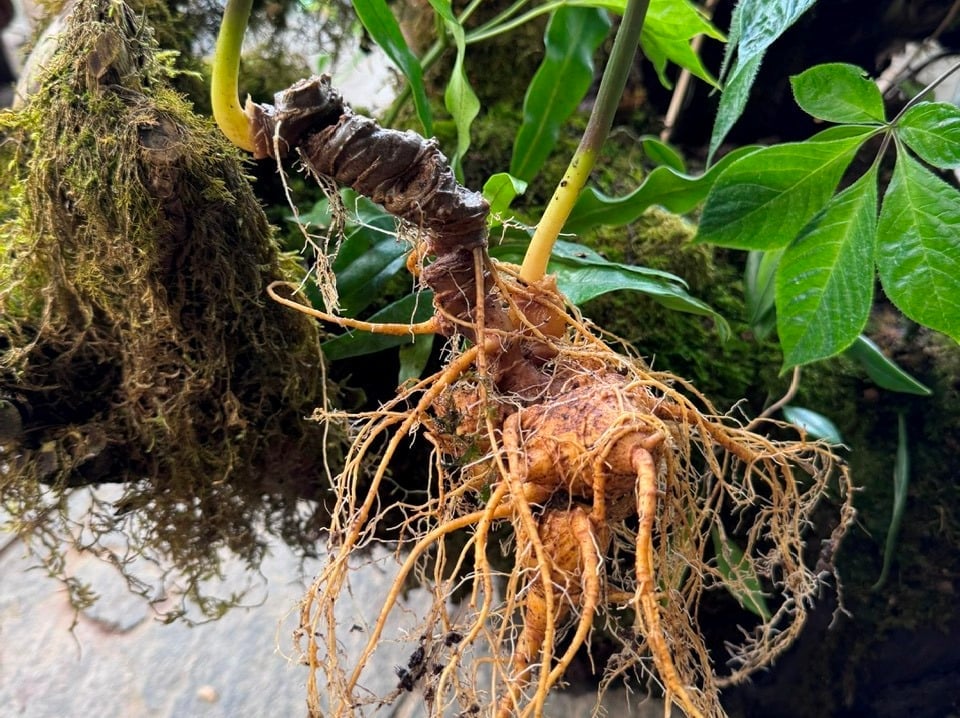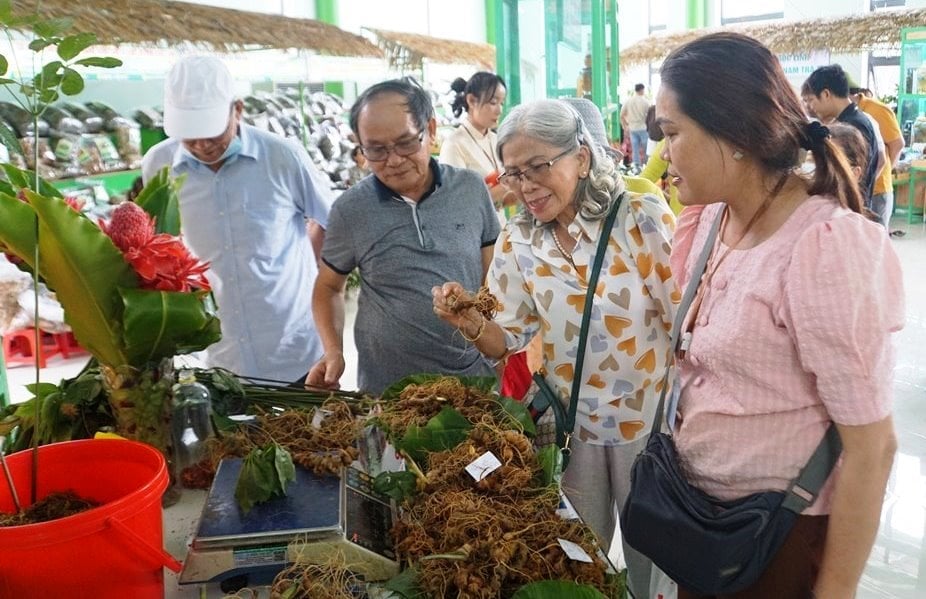November 19, 2025 | 08:18 GMT +7
November 19, 2025 | 08:18 GMT +7
Hotline: 0913.378.918
November 19, 2025 | 08:18 GMT +7
Hotline: 0913.378.918
Da Nang, with over 70% of its natural area classified as forest land and a rich, diverse ecosystem, is home to more than 832 medicinal plant species, including several rare and valuable varieties such as Ngoc Linh ginseng, schisandra, morinda officinalis, and codonopsis. Recognizing this potential, the city has introduced a series of important mechanisms and policies, with Ngoc Linh ginseng selected as the flagship crop to drive the development of a national-scale herbal medicine industry hub.
The city has designated a conservation and development zone for Ngoc Linh ginseng covering 15,567 hectares, mostly located at elevations above 1,200 meters. To date, approximately 1,294 hectares have been cultivated. More than 18 organizations, enterprises, and 41 household groups have completed applications to lease 825 hectares of forest land for ginseng cultivation. Among them, three enterprises have already been granted the right to use the geographical indication Ngoc Linh for their ginseng root products, with over 35,000 plants certified for origin.

Ngoc Linh ginseng is a rare, endemic medicinal plant of Da Nang’s mountainous region. Photo: Lan Anh.
Beyond increasing cultivation areas, Da Nang has also invested in numerous infrastructure projects for ginseng-growing regions, including the restoration of more than 800 hectares of forest, the establishment of protective systems, and the creation of quality inspection frameworks for ginseng. These measures have contributed to ensuring a stable and standardized supply of raw materials.
At the same time, scientific research and technological applications have been strongly promoted, with projects on propagation, gene preservation, and the use of the Internet of Things (IoT) for monitoring original ginseng zones, as well as the application of biological methods for pest management. Thanks to these efforts, the rate of standard-quality seedlings released from nurseries rose significantly, from 18.5% in 2015 to 53.48% in 2020.
Alongside Ngoc Linh ginseng, between 2016 and 2025 the city has supported the cultivation of 905 hectares of codonopsis, purple morinda officinalis, and purple cardamom, achieving 99.46% of its planned target. The seedling production system has also been strengthened, with 12 facilities now capable of supplying more than 2 million seedlings annually. These foundations represent an important stepping stone for Da Nang in its journey toward becoming the nation’s herbal medicine hub.
Building on these achievements, on February 28, 2025, Prime Minister issued Decision No. 463/QĐ-TTg approving the project Development and Establishment of a National Herbal Medicine Hub in Former Quang Nam Province, with Ngoc Linh ginseng designated as the core crop.
Accordingly, the Herbal Medicine Industry Center in the former Quang Nam province will serve as the central hub for research, production, deep processing, and commercialization of herbal products with Ngoc Linh ginseng as its flagship.

Ngoc Linh ginseng roots displayed for sale by local residents at the monthly Ngoc Linh Ginseng Fair in Nam Tra My. Photo: Lan Anh.
According to the project plan, during the period 2025-2035, the former Quang Nam province will maintain and expand suitable raw material areas, with priority given to the development of Ngoc Linh ginseng and other medicinal plants with competitive advantages.
Before 2030, the province aims to complete land-use planning and related zoning schemes, identify land plots, and gradually invest in infrastructure for the Herbal Medicine Industry Center within local industrial parks. At the same time, it will upgrade and complete regional infrastructure and transport connectivity to facilitate the growth of and investment attraction into the herbal medicine industry.
Mr. Ho Quang Buu, Vice Chairman of the Da Nang People’s Committee, emphasized that this is the foundation for Da Nang to position itself as a hub for attracting domestic and international enterprises to invest in the production, processing, and distribution of medicinal plants, with Ngoc Linh ginseng as the flagship. This, he noted, will also foster socio-economic infrastructure development, particularly promoting local economic growth and poverty reduction.
Immediately following this, Da Nang organized an investment promotion conference with nearly 100 enterprises in attendance, announced the launch of an e-commerce platform dedicated to Ngoc Linh ginseng, and continued to maintain its monthly Mountainous Agricultural and Herbal Fair. The city also plans to host the International Ginseng Festival from August 1-3, 2025, bringing together partners from South Korea, Japan, the United States, Germany, and beyond, to promote the brand on a global scale.

Da Nang is making strong efforts to conserve and develop the genetic resources of Ngoc Linh ginseng. Photo: Lan Anh.
Alongside trade promotion, infrastructure to support the herbal medicine industry continues to be prioritized. Currently, the former Quang Nam province hosts 16 industrial parks, 8 of which have industries linked to herbal medicine. Notably, the Nam Thang Binh Industrial Park, covering 649 hectares, has recently had its master plan approved, with a focus on attracting investment in high-tech herbal medicine processing.
On May 10, 2025, at the conference to implement Decision No. 463, the province signed cooperation agreements with 9 enterprises, with total committed capital exceeding VND 5,000 billion. Among these, THACO Agri plans to invest in 1,250 hectares of ginseng and medicinal plant cultivation (with raw material areas under survey). Several large-scale processing factories have also been licensed, such as the Huong Que Nam Herbal Pharmaceutical Plant with a total capital of VND 234 billion.
In terms of science and technology, the city is rolling out a research program for the development of Ngoc Linh ginseng and other medicinal plant products. It is also set to host the scientific conference "Ngoc Linh ginseng: From national product to global brand" on August 1, 2025, while selecting two research projects on medicinal plant conservation and the transplantation of Ngoc Linh ginseng.

Da Nang holds a monthly Mountainous Agricultural and Herbal Fair to promote Ngoc Linh ginseng. Photo: Lan Anh.
In terms of policy, Da Nang has proposed that the Government allow the application of investment incentive mechanisms under Decree No. 57/2018/NĐ-CP and has already implemented Decree No. 183/2025/NĐ-CP on the cultivation of medicinal plants in forest areas. The city’s Department of Agriculture and Environment has also provided guidance to localities and forest management units to facilitate the participation of enterprises and local communities in developing raw material zones.
Furthermore, the city has proactively integrated multiple funding sources, including allocations from the central budget and the National Target Program for Socio-Economic Development in Ethnic Minority and Mountainous Areas, to continue investing in the cultivation of valuable medicinal plants.
With its abundant natural endowments, a well-defined strategic vision, and the concerted efforts of local authorities, businesses, and communities, Da Nang is determined to elevate Ngoc Linh ginseng and other medicinal plants into the cornerstone of a national herbal medicine technology hub. This commitment not only strengthens the city’s role as a center of innovation and production but also contributes to enhancing the global standing of Vietnam’s herbal medicine brand on the international market.
Translated by Kieu Chi

(VAN) Fishermen and authorities in Khanh Hoa province are demonstrating strong resolve in the fight against IUU fishing, aiming to develop a sustainable fisheries sector and remove the European Commission's (EC) ‘yellow card.’

(VAN) Viet Nam has declared that it will develop and implement strong greenhouse gas reduction measures to achieve Net Zero emissions by 2050 and it is following through on that commitment.

(VAN) A comprehensive legal framework, tailored to domestic conditions, serves as the foundation guiding economic sectors toward low-emission development.

(VAN) Mastering technical skills and leveraging the advantages of Dau Tieng Lake, residents of Loc Ninh have created a sustainable pathway out of poverty.

(VAN) The entire political system of Dak Lak is taking strong and synchronized action against IUU fishing. The province has achieved a 100% rate of installing VMS on vessels over 15 meters in length.

(VAN) Geology and minerals play a foundational role, providing 'green and high-tech materials' for sustainable economic development.

(VAN) After 80 years, Lang Son’s agriculture and environment sector has affirmed its position through innovative thinking, modernized management toward a green, smart, and sustainable development.